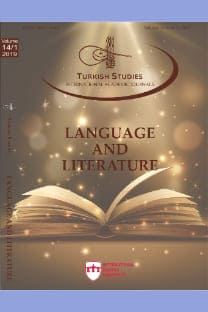ESKİ BAŞKENTTE CİNAYET: AHMET ÜMİT’İN İSTANBUL HATIRASI’NDA TARİHSEL İSTANBUL
Bu makale, Ahmet Ümit’in İstanbul Hatırası (2010) romanında cinayet ve şehir ilişkisi ekseninde, çeşitli mimari anıtların ve onların banisi tarihi kişiliklerin yazınsal temsilinden şehrin kültürel çeşitliliğini vurgulamak üzere nasıl yararlandığını inceliyor. Her ne kadar Ümit’in eseri özünde dedektiflerin seri katillerin peşinde şehrin caddelerini arşınladığı modern bir polisiye roman olsa da anlatıda hem İstanbul’un Byzantion, Roma, Bizans ve Osmanlı dönemlerine ait uzak geçmişinin hem de roman başkişisinin çocukluğunun kültürel çeşitlilik sergileyen semtine ait anılarının tasviri önemli bir yer tutar. Çalışma, flâneur figürü ile modern dedektif arasındaki münasebet üzerine tartışmalar çerçevesinde, kentin sokaklarını arşınlayan ana kahramanın sürekli modern şehrin kentsel manzarasını oluşturan mimari anıtlarını gözlemlediği bir anlatı yaratarak romancının İstanbul’un geçmişine ilişkin karmaşık katman ve dokuları açığa çıkardığını ileri sürüyor. Bu doğrultuda roman, İstanbul’u kolektif anlatılarla bireysel anıların kesiştiği, tarihî yapılarla çağdaş kent peyzajının yan yana yer alışı gibi farklı dönemlerden farklı kültürlerin harmanlandığı bir palimpseste dönüştürür. Romanda baş komiser Nevzat, çağdaş okur için şehri mütemadiyen gözlemleyen, şehrin mimari yapılarının öykülerini yeniden keşfeden ve anlatan bir hikâye anlatıcısı ve geçmişle şimdi arasında bir arabulucu işlevi görüyor. Böylelikle, İstanbul’un karmaşık ve çok çeşitli geçmişine ilişkin kavrayışımıza derin bir vuzuh sağlayan roman, İstanbul’un manzarasının asırlar boyunca sürekli nasıl yenilendiğini, yıkıldığını ve yeniden biçimlendirildiğini betimlerken kentin geçmişiyle ilişkimizi yeniden değerlendirmemizi olanaklı kılıyor.
CRIME IN THE OLD CAPITAL: HISTORIC ISTANBUL IN AHMET ÜMİT’S A MEMENTO FOR ISTANBUL
This article discusses the complex and ambiguous images ofIstanbul in a work of contemporary Turkish fiction: Ahmet Ümit’sİstanbul Hatırası [A Memento for Istanbul] (2010). It aims to show how theauthor utilizes the literary representation of various architecturalmonuments and the historical figures who erected them in order toemphasize the city’s ethnic, cultural, architectural and linguisticcomplexity. Within the framework of discussions on the relationshipbetween the flâneur figure and the modern detective, the study arguesthat although the novel is fundamentally a contemporary murdermystery, in which the detectives stroll through the streets of an urbancity to find a serial killer, the portrayals of both Istanbul’s distant historyduring the Byzantium, Roman, Byzantine and Ottoman periods and theprotagonist’s memories of the culturally diverse neighborhood of hischildhood occupy a substantial place. Accordingly, Ümit, a leadingcontemporary Turkish detective novelist, effectively uses theintermingling of a contemporary detective mystery with stories of thearchitectural history of Istanbul over centuries and the depiction of theold city during the protagonist’s childhood to challenge the dominantrepresentation of Istanbul in Turkish fiction. This narrative strategy inÜmit’s novel turns Istanbul into a palimpsest in which layers ofarchitectural monuments, memories, histories, stories, and culturesfrom different periods come together to define its contemporary urbanspace. By doing this, A Memento for Istanbul also provides profoundinsights into our understanding of Istanbul’s complex and multiple pastthrough the author’s skillful blending of depictions of the contemporaryurban city with those of the ancient capital. The novel thus informs thereader not only about the complexity, diversity and heterogeneity ofhistoric Istanbul, but also appeals to the reader to preserve itscosmopolitan heritage.
___
- Auster, P. (1988). The New York trilogy. London: Faber and Faber.
- Baudelaire, C. (2010). The painter of modern life and other essays (J. Mayne, Trans.). London: Phaidon.
- Benjamin, W. (1999). Charles Baudelaire: A lyric poet in the era of high capitalism (H. Zohn, Trans.). London: Verso.
- Birkerts, S. (1983). Walter Benjamin, Flâneur: A flanerie. The Iowa Review, 13(3-4), 164-179. doi:10.17077/0021-065x.2961
- Boutin, A. (2012, 07). Rethinking the flâneur: flânerie and the senses. Dix-Neuf, 16(2), 124-132. doi:10.1179/dix.2012.16.2.01
- Boym, S. (2002). The future of nostalgia. New York: Basic Books, a member of the Perseus Books Group.
- Certeau, M. D. (1988). The practice of everyday life (S. Rendall, Trans.). Berkeley: University of California Press.
- Dickens, R. (2004, 26 April). An eye on the city: The detective figure in Benjamin, Kracauer and Jameson. Retrieved from http://www.aughty.org/pdf/eye_on_city.pdf
- Harding, D. (2004). Writing the city: Urban visions and literary modernism. New York and London: Routledge.
- Massey, D. (1999). On space and the city. In D. Massey et al. (Eds.), City worlds (pp. 151-174). New York and London: Routledge.
- Parsons, D. L. (2003). Streetwalking the metropolis: Women, the city and modernity. New York and London: Oxford University Press.
- Pogossian, T. (2016). The art of walking in space and time: The quest for London. In K. Benesch & F. Specq (Eds.), Walking and the aesthetics of modernity (pp. 129-140). New York: Palgrave Macmillan. doi:10.1057/978-1-137-60364-7_9
- Sennett, R. (1996). Flesh and stone: The body and the city in western civilization. New York and London: W. W. Norton & Company.
- Ümit, A. (2010). İstanbul hatırası. İstanbul: Everest.
- Ümit, A. (2011). A memento for Istanbul (R. Jobanputra, Trans.). Istanbul: Everest.
